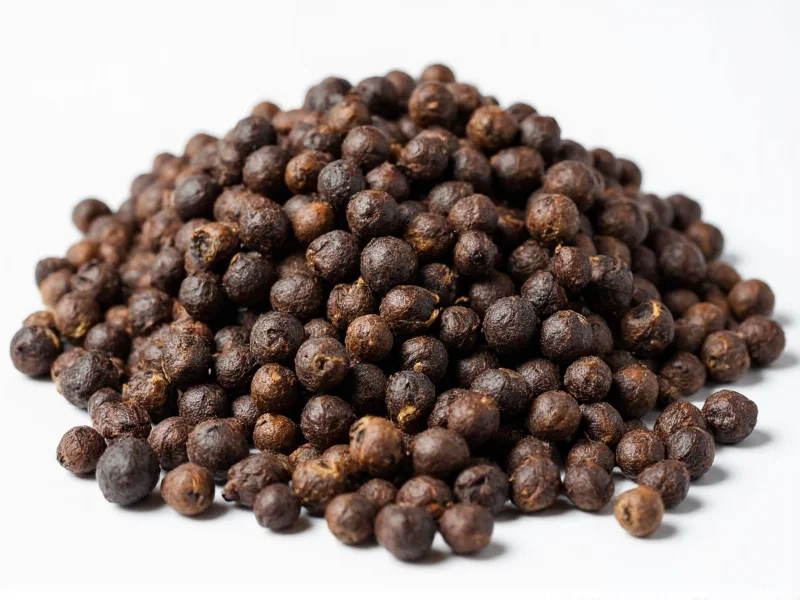Understanding the terminology around pepper can prevent confusion in recipes and grocery shopping. Many home cooks wonder is whole black pepper the same as peppercorn, especially when recipes call for one term while spice jars use another. The simple truth is they’re identical—just different ways of describing the same spice in its whole form.
What Exactly Is a Peppercorn?
A peppercorn is the fruit of the Piper nigrum vine, native to tropical regions of South Asia. When harvested unripe and dried, these small berries become what we know as black peppercorns. Despite the name “corn,” peppercorns aren’t related to cereal grains—they earned this designation from Old English “ corn,” meaning “small seed or grain.”
Types of Peppercorns Explained
While black peppercorns are most common, the Piper nigrum plant produces several pepper varieties based on harvest timing and processing:
| Type | Harvest Stage | Processing Method | Flavor Profile |
|---|---|---|---|
| Black Peppercorns | Unripe green berries | Sun-dried until wrinkled and dark | Sharp, pungent, complex heat |
| White Peppercorns | Ripe red berries | Soaked to remove outer layer, then dried | Milder, earthier, less complex |
| Green Peppercorns | Unripe berries | Preserved in brine or freeze-dried | Fresher, fruitier, milder heat |
| Red Peppercorns | Ripe berries | Dried with outer layer intact | Sweeter, fruitier, floral notes |
Why the Terminology Confusion Exists
The question is whole black pepper the same as peppercorn arises from inconsistent labeling practices and regional language differences. Grocery stores often label whole spices as “peppercorns” to distinguish them from ground pepper, while recipes might specify “whole black pepper” for clarity. Both terms correctly describe the same product: intact black peppercorns before grinding.
Culinary Applications of Whole Black Peppercorns
Understanding that whole black pepper equals peppercorn matters for cooking techniques. Chefs prefer whole peppercorns for:
- Pickling and brines—whole peppercorns release flavor slowly without making liquids cloudy
- Stocks and soups—easily removable after infusion
- Pepper mills—freshly ground pepper provides superior flavor and aroma
- Whole spice rubs—cracked peppercorns create texture contrast
Ground pepper works better when immediate flavor dispersion is needed, but loses potency faster. For maximum shelf life, store whole peppercorns in an airtight container away from light and heat—they’ll retain freshness for 2-3 years versus 6 months for pre-ground pepper.
Common Misconceptions About Peppercorns
Several myths persist about black pepper vs peppercorn meaning. Let’s clarify:
- Myth: “Peppercorn” refers to a specific pepper variety
Fact: It’s the general term for whole pepper berries regardless of color - Myth: All peppercorns come from the same processing method
Fact: Color variations result from different harvest times and processing - Myth: Whole black pepper is stronger than ground
Fact: Strength is identical—freshly ground offers more volatile aromatic compounds
Maximizing Flavor From Your Peppercorns
Since whole black pepper and peppercorn are identical, proper handling ensures optimal flavor. Toasting peppercorns in a dry pan for 1-2 minutes before grinding enhances their essential oils. For recipes specifying “cracked pepper,” use a mortar and pestle or spice grinder pulse setting to achieve varied particle sizes that distribute flavor more evenly than uniformly ground pepper.
Shopping Tips for Peppercorn Selection
When choosing between products labeled “whole black pepper” or “peppercorns,” look for:
- Firm, heavy berries (indicates freshness)
- Uniform dark brown to black color
- No signs of moisture or mold
- Whole, unbroken spheres (cracks indicate age)
Vietnamese Tellicherry and Malaysian Sarawak varieties offer particularly complex flavor profiles for those exploring types of peppercorns explained beyond basic supermarket options.











 浙公网安备
33010002000092号
浙公网安备
33010002000092号 浙B2-20120091-4
浙B2-20120091-4